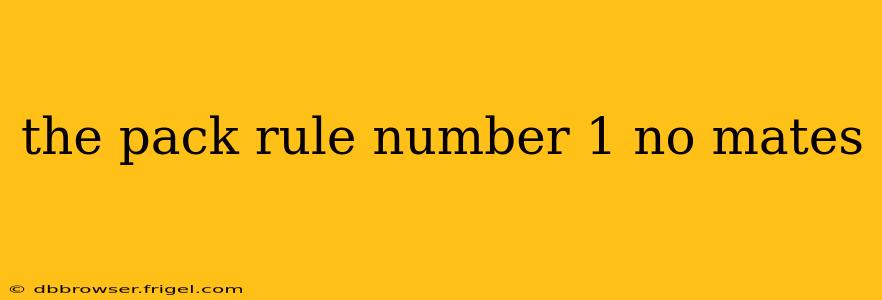The Pack Rule #1: No Mates? Deconstructing the Myth of Canine Hierarchy
The phrase "pack rule #1: no mates" is a highly controversial and largely inaccurate statement often used to explain canine behavior, particularly in the context of dog training. This assertion, frequently associated with outdated and now-discredited dominance theories, suggests that dogs in a pack will actively prevent breeding or mating among their members. The truth is far more nuanced and complex than this simplistic rule suggests.
Let's delve into why this "rule" is problematic and explore a more accurate understanding of canine social dynamics.
What is the Origin of the "Pack Rule #1: No Mates" Idea?
This idea stems from early interpretations of wolf pack behavior, which were often anthropomorphized and lacked the benefit of modern, in-depth research. Early observations, while not completely unfounded, oversimplified the complex social structures of wolves and inappropriately applied those interpretations to domestic dogs. The idea of a strict, linear hierarchy where a dominant alpha dog suppresses all others, including reproduction, is now largely rejected by ethologists and canine behavior experts.
Do Wolves Really Follow a "No Mates" Rule?
The reality is that wolf packs are far more intricate than a simple dominance hierarchy. While there are dominant breeding pairs, the idea that they ruthlessly suppress all other mating attempts is inaccurate. Subordinate wolves may indeed have limited opportunities to breed, but this is more related to factors like access to resources and the established social structure than a strict "no mates" rule enforced by the alpha pair. Young wolves will often leave the pack to establish their own territories and reproduce.
How Does This Apply to Domestic Dogs?
Domestic dogs, having been selectively bred for thousands of years, have significantly different social structures than wolves. Their behaviors are influenced by human interaction and domestication. Applying wolf pack dynamics directly to dogs is a major oversimplification and often leads to misinterpretations of their behavior. Dogs exhibit a wide range of social behaviors, influenced by breed, individual personality, and their experiences.
What are the Real Dynamics of Dog Social Groups?
Instead of a rigid hierarchy, canine social dynamics are best understood as a complex interplay of individual relationships, communication, and resource competition. This means that dogs within a household might exhibit various forms of dominance or submission, but it is not a fixed, linear ranking. Furthermore, the idea of a dominant dog suppressing all potential mating within a group is not supported by observation or scientific evidence.
Why is the "No Mates" Idea Harmful?
The misconception of a "pack leader" who must enforce strict dominance, including the prevention of breeding amongst pack members, can lead to harsh and ineffective training methods. Attempting to impose this flawed paradigm on a dog may lead to stress, anxiety, and behavioral problems. A more humane and effective approach focuses on building a positive, trust-based relationship with the dog through positive reinforcement techniques and clear communication.
Is there a specific hierarchy in a dog pack?
While dogs certainly display social hierarchies, it is inaccurate to describe them as a strict, linear "pecking order." Their social interactions are nuanced and complex, involving individual relationships, communication signals, and the availability of resources. The dominance and submission behaviors observed among dogs are flexible and context-dependent, rather than rigidly defined roles.
How does the environment influence a dog's social behavior?
A dog's environment significantly influences its social behavior. Factors such as the availability of resources (food, space, toys), the presence of other dogs, and human interactions all play vital roles in shaping a dog's social dynamics. This includes its interactions within a "pack" or social group. Dogs will exhibit different behaviors in different contexts.
In conclusion, the notion of "pack rule #1: no mates" is a harmful oversimplification of canine social behavior. Understanding the complex and nuanced social dynamics of dogs requires moving beyond outdated and inaccurate interpretations of wolf behavior and embracing a more modern, scientifically-grounded approach to canine behavior analysis and training.
